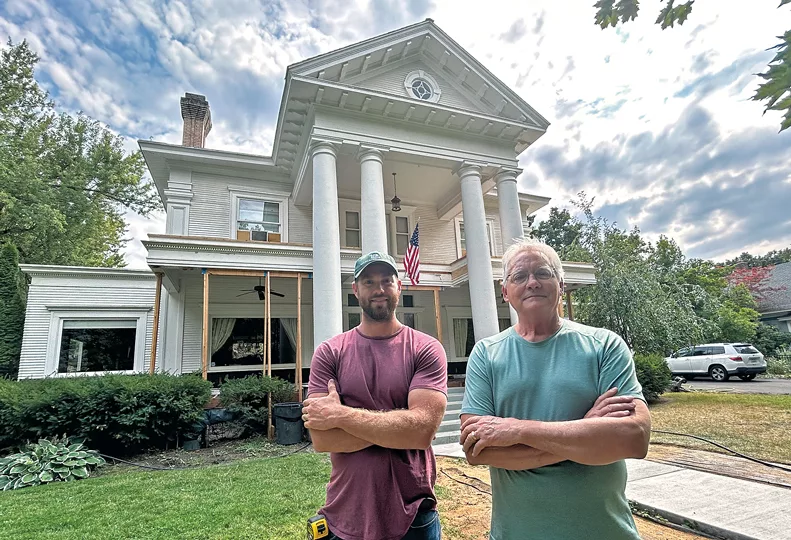Manito home's historic exterior is under renovation
Homeowner returns four decades later to do more work on house

Richard Palmer, right, and Mike Walsh say they will replace the 10 columns on the front of the Manito White House with materials more suited to withstand Pacific Northwest weather.
| Karina EliasRichard Palmer never imagined he would return to and renovate the first home he owned over 40 years ago.
However, as a contractor, he was hired by the home's new owners to renovate and restore the exterior of the historic Daniel Morgan home. or more commonly, the Whitehouse on Manito or the Manito White House, prominently situated on the southeast corner of Grand Boulevard and Manito Place.
Last month, Spokane-based Mike Walsh Construction Company LLC began work on the historic home located at 242 E. Manito Place to the tune of about $160,000. Palmer and Mike Walsh are tearing out the 115-year-old front porch as well as replacing the large 20-foot columns that stand on the entrance of the home and support a canopy that extends over the porch and second-floor veranda. The 10 smaller 8-foot pillars that are set evenly along the porch and support the second-floor veranda also will be replaced with materials that can withstand the Pacific Northwest weather better, Palmer says.
“You know you’re getting old when Mother Nature has reclaimed the work you did in your youth,” says Palmer, who is 68. “But we were poor college students and couldn’t afford to replace all of (the columns). These have now let the world know that it’s time for them to go.”
Walsh says there are a few options for replacing the columns such as precast fiberglass, stone, or composite materials. As he and Palmer evaluated the state of the columns, it became obvious that the porch needed some restoration, as well as the upper deck gutter system. If no more projects are added to the list of renovations, he estimates the work will be completed by October.
“Everything that was exposed to the weather was just eaten away and deteriorating,” Walsh says. “Some spots you could put your hand through.”
The Hazleton family currently owns the Manito White House. Rebecca Hazleton was introduced to Palmer through her neighbors. She first asked Palmer if he could move the walkway—which extended from the east side of the sidewalk and curved its way to the middle of the house—into a straight walkway from the curve to the front porch. After that was completed, she hired Palmer and Walsh to do more work.
“It’s good to have someone who knows and loves the home do the restoration work,” Hazleton says.
Palmer started his construction company Nomads Construction LLC in 2016 after 30 years as an Apple Systems engineer. Nomads stands for “nice old men actually doing something” because he says he never really wants to retire. About two years ago, he sold the company for $100,000 to Walsh, who has since renamed it. The company has three full-time employees, and Palmer works part-time. The company has built homes near Kendall Yards and has about half a dozen projects underway. Since the pandemic, they have been busy with renovation work, Walsh says.
“You start doing that stuff and the word gets around and your phone just doesn’t stop ringing,” he says.
When they began applying for permits to renovate the Manito White House, they soon discovered that as a historic place as of 2012, their renovations needed to pass merit with Spokane City-County Historic Preservation Office to obtain a “certificate of appropriateness” before they could be issued any permits.
According to Megan Duvall, historic preservation officer, the certificate of appropriateness is required for any property that is listed on the Spokane Register of Historic Places or within a Spokane Historic District. The office looks for certain things such as color and quality of materials.
The Manito White House was constructed in 1909 for Daniel Morgan, a Spokane entrepreneur, developer, and Washington state senator, according to the Historic Preservation office. The home sits on about 1/3 acre of land and is oriented north, facing the eastern portion of Manito Park.
It has about 6,200 square feet of space, including a basement and unfinished 1,200-square-foot attic with high ceilings that could be converted into a ballroom, Palmer says. The home has five bedrooms, three baths, and three fireplaces. On the main floor, a wide entry leads to a library and grand staircase, and the west wing addition is commonly used as a bedroom. The interior of the home is decked in Philippine Mahogany, and its ceilings are adorned with carved plaster, Palmer says.
 -Karina Elias
-Karina EliasRichard Palmer owned the Manito White House in the 1980s and returned it to a single-family home from a duplex.
According to the Historic Preservation Office, the Manito White House was nominated to the Spokane Register of Historic Places as an “excellent example of a neoclassical dwelling in Spokane,” and is an important example of residential work completed by renowned architects Harold C. Whitehouse and George H. Keith. The nomination notes that the home retains its integrity of location, design, and workmanship. The nomination application submitted by Pete Chase, former owner of the Manito White House, refers to newspaper articles from 1909 that describe the home as the most expensive home erected in the Manito Park District in 1909, with an “expressive interior and elegant finish.” Morgan had purchased the lots in 1902 for $2,016 and built the home for $16,000, according to a nomination letter with the Historic Preservation Office.
Palmer lived across Grand Boulevard in the early 1980s and would often see an older woman, dressed finely, tending to her roses in the front of the Manito White House while on his daily runs. He eventually became friends with Margaret Hebberd, who had received the home as a wedding gift from her husband during the Great Depression. According to the Historic Preservation Office, the home was purchased in 1931 in a foreclosure agreement by the Hebberds for $13,500. Before that, the home had gone through several hands over two decades and was used as a soup kitchen and flophouse during the Great Depression, according to records from the Historic Preservation Office.
By the time Palmer met Hebberd, she was a widow and had turned the home into a duplex. When Palmer discovered this, he told Hebberd he’d love to live there if it ever became vacant.
“About six months later, she called me up and said it was available,” Palmer says. “My wife and I thought we had died and gone to heaven to rent the second story in this house.”
At that point, Palmer was a hairdresser making his living cutting mullets and big '80s hair, he says. His wife was in graduate school pursuing a doctorate in psychology. Hebberd and her husband had been high-society people who traveled the world and would purchase furniture for their store, Tull & Gibbs, a four-story furniture store in downtown Spokane, Palmer says. Hebberd was also a founding benefactor to the Spokane Civic Theater and gave much of her time to it, he says.
Eventually, Hebberd started showing signs of dementia and needed to move into a care home. Before leaving, she shared that she wanted the Palmers to own the home. Hebberd’s daughter tallied up the work Palmer had done, such as mowing the lawn and replacing the water heater, and gave them a large credit, he says. She also deducted work that the home still needed to have and sold the home for $111,000 to the Palmers in 1982.
“The day we bought it, we went and sat across the street and looked at it and just thought, how are we going to come up with $650 a month?” Palmer recalls. “We didn’t have furniture to fill it up or could afford to heat it … but eventually we started making money and had three little kids.”
The Palmers lived at the Manito White House for 10 years, and during that time undertook several renovation and preservation projects including converting the then duplex into a single-family home, replacing two of the 20-foot columns, updating plumbing and electrical lines, adding fresh paint, and repairing glass work that decorates the wooden front door. They sold it in 1992 for $250,000.
Over the past three decades, Palmer has known all of the owners, who are always eager to know more about the history of the home.
After Palmer, a Southern gentleman named George French, who had made his fortune in commercial real estate, occupied the Manito White House for about 15 years. He became “Grandpa George” and like a member of the family, Palmer says. French was a collector of antique clocks, had the ceilings carved in plasterwork, and named the home “Tierra Bella” or beautiful land.
Spokane entrepreneur Pete Chase, best known as the co-founder of telecommunications cabinet manufacturer Purcell Systems Inc., purchased the Manito White House in 2009 for $498,000, according to public records, and is credited for renovating the home and nominating it to the city's historic register.
The Hazletons purchased the home for $925,000 in 2019. Hazleton says the previous owners had left behind binders of notes detailing nearly a century of work and the history of the home. She plans to continue to care for the historic home and add records to the binders.
Palmer, who is proud of the glass work he did on the house, says he might start a leaded glass studio.




_web.webp?t=1764835652)
